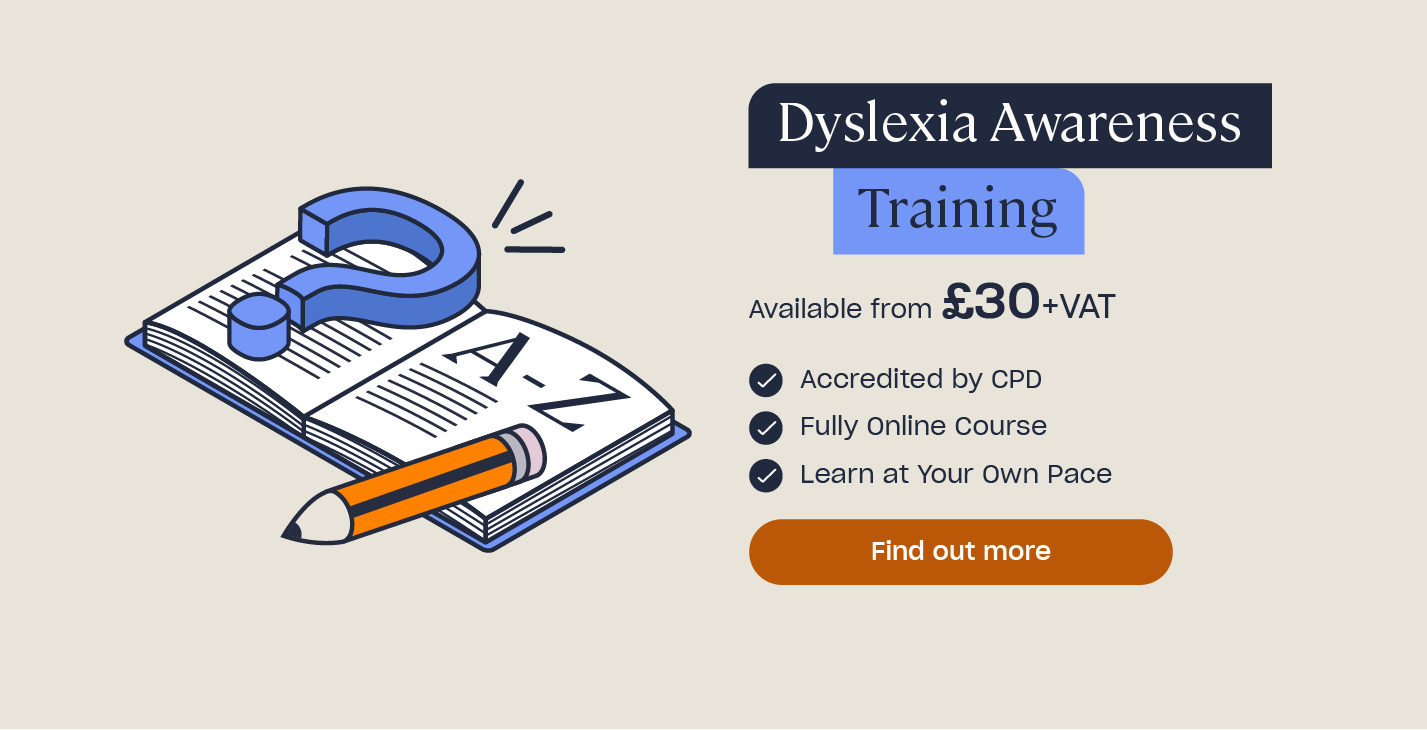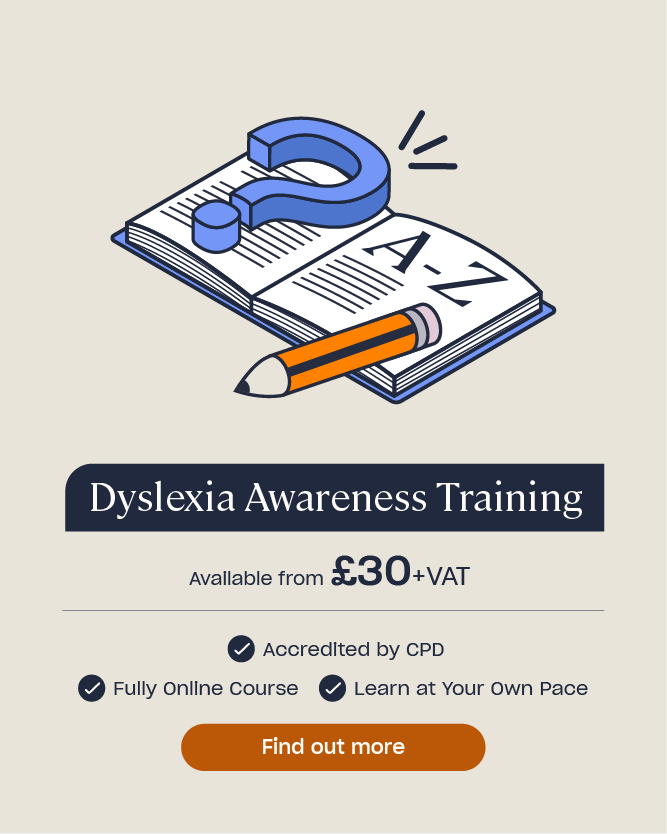Recognising the Signs of Dyslexia in Children
Dyslexia is a neurodevelopmental disorder predominantly affecting a person’s ability to read, write, and spell accurately by affecting their ability to process and remember information. Dyslexia is recognised as a learning disability and aspects of dyslexia may be seen in language skills, motor coordination, mental calculation, concentration and personal organisation.
In this article, we will cover what dyslexia is, how to spot the various indicators of dyslexia in different age groups of children and what to do if you suspect your child has Dyslexia.
What is Dyslexia in Children?
Dyslexia in children often involves difficulties with word recognition, spelling, and decoding abilities. The challenges faced by children with dyslexia are primarily associated with problems in phonological processing.
Diagnosis can be difficult until a child shows definitive, long-term signs. It may go undiagnosed well into teen years or adulthood; some people with dyslexia may even hide their difficulties, meaning that they don’t receive the necessary support. It is important to note that dyslexia is not related to intelligence; individuals with dyslexia often have average or above-average intelligence.
Understanding the signs of dyslexia is crucial for parents and educators to provide timely support and interventions, setting the foundation for effective learning strategies that are tailored to the child’s needs.

Dyslexia in Toddlers
Identifying signs of dyslexia in toddlers (ages 2 to 4) requires a keen observation of early language and literacy development. While variations in individual development are natural, certain indicators may suggest the need for closer attention to potential dyslexic traits in toddlers, such as:
- Delayed Speech Development: Toddlers with dyslexia may exhibit slower speech development than their peers, struggling with acquiring and pronouncing words.
- Rhyming Challenges: Difficulty engaging in rhyming games or recognising rhyming words is a potential early sign as phonological awareness develops during these formative years.
- Limited Interest in Alphabet Activities: A reduced interest or reluctance to engage with alphabet-related activities, such as learning the names of letters or associating them with sounds, may be indicative.
- Difficulty Remembering Words: Toddlers with dyslexia may have trouble remembering and recalling familiar words, impacting early vocabulary development.
- Speech Sound Errors: Pronunciation challenges, including persistent speech sound errors, may be noticeable as the toddler attempts to communicate verbally.
- Delayed Motor Skills: Dyslexic toddlers might also display delayed fine motor skills, affecting activities like holding a crayon or pencil, which can be linked to challenges in letter formation later on.
It’s essential to approach these signs with sensitivity and recognise that variations in development are to be expected. However, if multiple signs persist or become more pronounced over time, consulting with a paediatrician or early childhood development specialist can provide valuable insights and guidance for further assessment and support. Early intervention plays a crucial role in mitigating the impact of dyslexia, enhancing the child’s overall language and literacy development.
Signs of Dyslexia in Kids
Dyslexia in kids aged 5 to 12 manifests as distinct challenges in acquiring foundational reading and writing skills. While each child develops at their own pace, certain signs may indicate potential dyslexic traits during these crucial formative years. Identifying signs of dyslexia in kids of this age involves recognising challenges in reading, writing, and language skills that may impede their academic progress. Here are specific signs to observe within this age range:
Reading and Writing Challenges 
-
- Slow and Hesitant Reading: Dyslexic kids may read slowly and hesitantly, struggling to decode words and maintain fluency.
-
- Difficulty Spelling: Persistent difficulties spelling common words and applying spelling rules accurately.
-
- Phonics and Decoding Issues: Struggles with applying phonics rules to decode unfamiliar words, leading to reading comprehension challenges.
-
- Inconsistent Reading Comprehension: Difficulty understanding and retaining information from reading materials, affecting overall comprehension.
Expressive Language Challenges 
-
- Written Expression Issues: Challenges in organising thoughts coherently and expressing ideas in writing.
-
- Avoidance of Writing Tasks: Reluctance to writing tasks, avoiding assignments requiring extended written expression.
-
- Sentence Structure and Grammar: Dyslexic kids may struggle with sentence structure and grammar in their written work.
Behavioural and Emotional Signs 
-
- Low Reading Engagement: A lack of interest in reading or choosing reading materials significantly below their age level.
-
- Avoidance of Reading Aloud: Reluctance to read aloud in class or participate in activities that involve reading aloud.
-
- Frustration and Low Self-Esteem: Persistent frustration with academic tasks and a decline in self-esteem related to perceived difficulties.
Social and Academic Impact 
-
- Difficulty Following Instructions: Challenges in understanding and following multi-step instructions affecting academic tasks and classroom activities.
-
- Peer Interaction Challenges: Dyslexic kids may face difficulties interacting with peers, especially in activities involving reading and writing.
Recognising these signs in the context of a child’s overall development is essential. Early intervention, specialised support, and collaboration between parents and educators can help to ensure a dyslexic child’s academic success and emotional well-being during these critical years.
Looking to Learn More?
If you work closely with children and young people, it can help to have a deeper understanding of dyslexia and how it affects those you work with. Check out our Dyslexia Awareness Course to expand your knowledge on what dyslexia is and how to support in improving outcomes for children.
Signs of Dyslexia in Teens
Teens with dyslexia may face increased challenges as academic demands intensify. Identifying dyslexia in teenagers involves recognising reading, writing, and academic difficulties that impact their educational journey. Recognition during adolescence is crucial for tailored support. Here are specific signs to observe within the 13 to 18 age range:
Reading and Writing Challenges 
-
- Reading Stamina: Dyslexic teens may exhibit slower reading and difficulty focusing on longer more complex texts.
-
- Spelling Struggles: Continued challenges in spelling, with potential reliance on memorisation rather than consistent application of spelling rules.
-
- Vocabulary Limitations: Impact on vocabulary development, leading to a more restricted and less diverse use of language.
Expressive Language Challenges 
-
- Writing Organisation: Teens with dyslexia may face challenges in organising thoughts in writing, resulting in less structured and precise compositions.
-
- Avoidance of Writing: Reluctance to engage in writing tasks that require extended expression of ideas, impacting academic assignments and assessments.
Behavioural and Emotional Signs 
-
- Self-Esteem Impact: Persistent academic challenges may contribute to lower self-esteem than peers.
-
- Frustration and Anxiety: Teens with dyslexia may experience heightened frustration and anxiety related to academic demands, especially in subjects requiring extensive reading and writing.
-
- Public Speaking Concerns: Reluctance to read aloud or participate in activities involving public speaking due to concerns about reading difficulties.
Social and Academic Impact 
-
- Task Coordination: Struggles in managing multiple tasks simultaneously, affecting performance in assignments requiring various skill coordination.
-
- Social Interaction Dynamics: Dyslexic teens may encounter difficulties in social interactions, especially in group settings involving academic discussions.
Identifying these signs during the teenage years is crucial for providing tailored support and accommodations to help teens navigate academic challenges and promote their overall well-being.
What to Do if You Think Your Child Has Dyslexia

If you suspect your child has dyslexia, seek professional evaluation. Educational psychologists or specialised assessment centres can provide a diagnosis. Support strategies include personalised academic plans, extra exam time, and specialised teaching methods. Schools may offer interventions, such as reading specialists or speech therapy. Additionally, parental involvement and fostering a positive attitude towards learning can significantly benefit children with dyslexia.
To find out more about supporting children with dyslexia in the classroom, take a look at our article: How to Help a Child with Dyslexia in the Classroom
Early identification and intervention are pivotal in empowering children with dyslexia to navigate educational challenges successfully. By understanding the signs and taking appropriate steps, parents and educators can create a supportive environment for children with dyslexia to thrive.
What to Read Next:
- How to Avoid Dyslexia Discrimination in the Workplace
- Dyslexia Awareness Training
- 8 Useful Apps to Help with Dyslexia
- How to Help a Child with Dyslexia in the Classroom
- How to Help a Child with Dyspraxia in the Classroom
- How to Support Individuals with Learning Disabilities
- How to Help a Child With Dyscalculia in the Classroom











